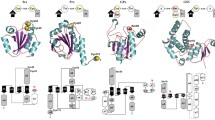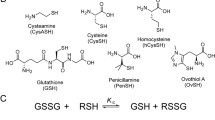Abstract
Qualitative and quantitative changes associated with cellular glutatione (GSH) in response to oxidants were investigated in cultured Chinese hamster V79 cells. Incubation of cells with benzoylperoxide (BZP), tert-butylhydroperoxide (t-BuOOH), hydrogen peroxide or diamide for 1 h reduced the level of total GSH (GSH + GSSG). Among the oxidants, t-BuOOH and diamide caused an increase in levels of glutathione disulfide (GSSG) and a resultant increase in the ratio of the level of GSSG to the level of total GSH, suggestive of the induction within the cells of a pro-oxidant state by the oxidants. o-Phenanthroline, a chelator of divalent ion, almost completely suppressed the decrease in levels of total GSH caused by t-BuOOH while it did not suppressed either increases in levels of GSSG or increases in the ratio of the levels of GSSG to that of total GSH caused by the hydroperoxide. These results suggest that reactive oxygen radicals are involved in the decrease in levels of GSH by treatment with t-BuOOH but not in the increase in the level of GSSG. After treatment with either t-BuOOH or diamide for 1 h, the level of GSH rapidly increased to more than twice the control level during 15–45 min of post-treatment incubation. o-Phenanthroline almost completely suppressed the increase in levels of GSH caused by t-BuOOH, while it did not affect the changes caused by diamide, suggesting a difference between the mechanisms by which t-BuOOH and diamide cause increases in levels of GSH. It seems likely that reactive oxygen radicals participate not only in the decrease in levels of GSH caused by t-BuOOH but also in the rapid increase that occurs after such treatment. Hence, the first decrease in levels of GSH by the hydroperoxide may be causally related to the latter increase. The amount of [35S]-cysteine taken up by cells after treatment with t-BuOOH was about one half of that taken up by control cells. By contrast, the rate of incorporation of radioactive cysteine into acid-soluble material increased to more than twice that of the controls after treatment with t-BuOOH. The increase in the rate of incorporation of [35S]cysteine into acid-soluble material caused by t-BuOOH was not a consequence of inhibition by the hydroperoxide of utilization of cysteine for protein synthesis. Inhibition of protein synthesis by cycloheximide caused neither an increase in the incorporation of cysteine into acid-soluble material nor an increase in rate of biosynthesis of GSH. Incorporation of radioactive cysteine into the cysteine moiety of GSH and the disappearance of the radioactivity from the cysteine fraction were enhanced after treatment with t-BuOOH. These data indicate that biosynthesis of GSH de novo is enhanced by t-BuOOH.
Similar content being viewed by others

References
Allen RG, Farmer KJ, Newton RK, Sohal RS (1984) Effects of paraquat administration on longevity, oxygen consumption, lipid peroxidation, Superoxide dismutase, catalase, glutathione reductase, inorganic peroxides and glutathione in the adult housefly. Comp Biochem Physiol 78C: 283–288
Allen RG, Newton RK, Farmer KJ, Nations C (1985) Effect of the free radical generator paraquat on differentiation, Superoxide dismutase, glutathione and inorganic peroxides in microplasmodia of physarum polycephalum. Cell Tissue Kinet 18: 623–630
Arrick BA, Nathan CF, Griffith OW, Cohn ZA (1982) Glutathione depletion sensitizes tumor cells to oxidative cytolysis. J Biol Chem 257: 1231–1237
Baker MA, Taylor YC, Brown JM (1988) Radiosensitization, thiol oxidation and inhibition of DNA repair by SR4077. Radiat Res 113: 346–355
Bannai S (1984) Induction of cystine and glutamine transport activity in human fibroblasts by diethyl maleate and other electrophilic agents. J Biol Chem 259: 2435–2440
Bannai S (1986) Exchange of cystine and glutamate across plasma membrane of human fibroblasts. J Biol Chem 261: 2256–2263
Bannai S, Ishii T (1982) Transport of cystine and cysteine and cell growth in cultured human diploid fibroblasts: effect of glutamate and homocysteate. J Cell Physiol 112: 265–272
Borghetti AF, Tramacere M, Ghiringhelli P, Severini A, Kay JE (1981) Amino acid transport in pig lymphocytes: enhanced activity of transport system ASC following mitogenic stimulation. Biochim Biophys Acta 646: 218–230
Cerutti PA (1985) Prooxidant states and tumor promotion. Science 227: 375–381
Christman MF, Morgan RW, Jacobson FS, Ames BN (1985) Positive control of a regulon for defense against oxidative stress and some heat shock proteins in Salmonella typhimurium. Cell 41: 735–762
Deneke S, Steiger V, Fanburg BL (1987) Effect of hyperoxia on glutathione levels and glutamic acid uptake in endothelial cells. J App Physiol 63: 1966–1971
Deneke SM, Baxter DF, Phelps DT, Fanburg RL (1989) Increase in endothelial cell glutathione and precursor amino acid uptake by diethylmaleate and hyperoxia. Am J Physiol 257: L265-L271
Eklow L, Moldeus P, Orrenius S (1984) Oxidation of glutathione during hydroperoxide metabolism; a study using isolated hepatocytes and the glutathione reductase inhibitor 1,3-bis(2-chloroethyl)-1-nitrosourea. Eur J Biochem 138: 459–463
Hishinuma I, Ishii T, Watanabe H, Bannai S (1986) Mouse lymphoma L1210 cells acquire a new cystine transport activity upon adaptation in vitro. In Vitro Cell Dev Biol 22: 127–134
Issels RD, Nagele A (1989) Promotion of cystine uptake, increase of glutathione biosynthesis and modulation of glutathione status by S-2-(3-aminopropylamino) ethyl phosphorothioic acid (WR-2721) in Chinese hamster cells. Cancer Res 49: 2082–2086
Keyse SM, Tyrrell RM (1989) Heme oxygenase in the major 32-KDa stress protein induced in human skin fibroblasts by UVA radiation, hydrogen peroxide and sodium arsenite. Proc Natl Acad Sci USA 86: 99–103
Kilberg MS, Handlogten ME, Christensen HN (1981) Characteristics of system ASC for transport of neutral amino acids in the isolated rat hepatocytes. J Biol Chem 256: 3304–3312
Kosower NS, Kosower EM (1987) Formation of disulfides with diamide. Methods Enzymol 143: 264–270
Lowry OH, Rosebrough NJ, Farr AL, Randall RJ (1951) Protein measurements with Folin phenol reagent. J Biol Chem 193: 265–275
Meister A (1988) Glutathione metabolism and its selective modification. J Biol Chem 263: 17205–17208
Meister A, Anderson ME (1983) Glutathione. Annu Rev Biochem 52: 711–760
Muhlematter D, Ochi T, Cerutti PA (1989) Effects of tert-butylhydro peroxide on promotable and non-promotabls JB6 mouse epidermal cells. Chem Biol Interact 71: 339–352
Ochi T (1988) Effects of glutathione depletion and induction of metallothioneins on the cytotoxicity of an organic hydroperoxide in cultured mammalian cells. Toxicology 50: 257–268
Ochi T (1989) Effects of iron chelators and glutathione depletion on the induction and repair of chromosomal abberrations by tert-butylhydroperoxide in cultured Chinese hamster cells. Mutat Res 213: 243–248
Ochi T (1990) Effects of an organic hydroperoxide on the activity of antioxidant enzymes in cultured mammalian cells. Toxicology 61: 229–239
Ochi T, Cerutti PA (1989) Differential effects of glutathione depletion and metallothionein induction on the induction of DNA single-strand breaks and cytotoxicity by tert-butylhydroperoxide in cultured mammalian cells. Chem Biol Interact 72: 335–345
Ochi T, Miyaura S (1989) Cytotoxicity of an organic hydroperoxide and cellular antioxidant defense system against hydroperoxide in cultured mammalian cells. Toxicology 55: 69–82
Oliver JM, Albertini DF, Berlin RD (1976) Effect of glutathione oxidizing agents on microtuble assembly and microtuble-dependent surface properties of human neutrophils. J Cell Biol 71: 921–932
Perchellet JP, Perchellet EM, Orten DK, Schneider BA (1986) Decreased ratio of reduced/oxidized glutathione in mouse epidermal cells treated with tumor promoters. Carcinogenesis 7: 503–506
Spitz DR, Deweg WC, Gloria CL (1987) Hydrogen peroxide or heat shock induces resistance to hydrogen peroxide in Chinese hamster fibroblasts. J Cell Physiol 131: 364–373
States B, Segal S (1969) Thin-layer Chromatographic separation of cystine and the N-ethylmaleimide adducts of cysteine and glutathione. Anal Biochem 27: 323–329
Storz G, Tartaglia LA, Ames BN (1990) Transcriptional regulator of oxidative stress-inducible genes: direct activation by oxidation. Science 248: 189–194
Takada A, Bannai S (1984) Transport of cystine in isolated rat hepatocytes in primary culture. J Biol Chem 259: 2441–2445
Tietze F (1969) Enzymic method for quantitative determination of nanogram amount of total and oxidized glutathione: applications to mammalian blood and other tissues. Anal Biochem 27: 502–522
Author information
Authors and Affiliations
Rights and permissions
About this article
Cite this article
Ochi, T. Mechanism for the changes in levels of glutathione upon exposure of cultured mammalian cells to tertiary-butylhydroperoxide and diamide. Arch Toxicol 67, 401–410 (1993). https://doi.org/10.1007/BF01977401
Received:
Accepted:
Issue Date:
DOI: https://doi.org/10.1007/BF01977401



